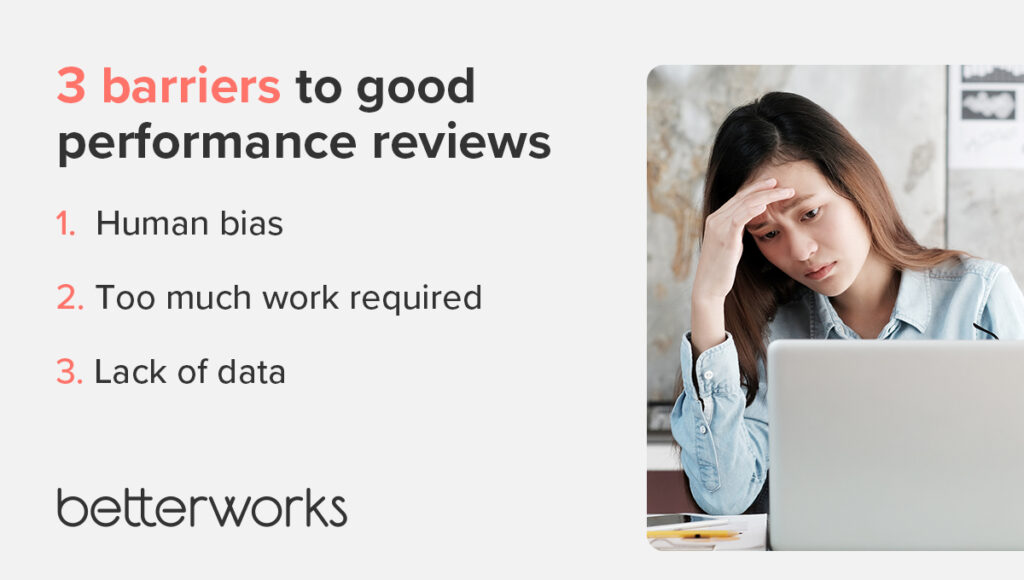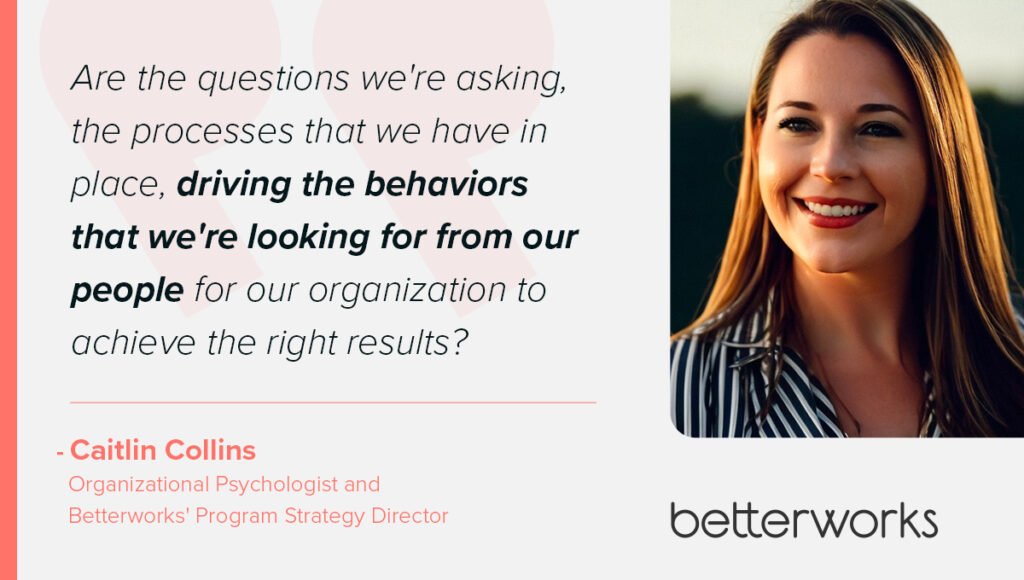Performance reviews are an important part of any company’s talent management strategy. However, the traditional approach often overwhelms and frustrates employees. Reviews can be time-consuming, and bureaucratic, and still fail to provide meaningful feedback. That’s why many companies are focusing on performance review process improvements to help their workforce become more productive and engaged.
It’s no secret that performance review processes are overdue for an update. Nearly half (42%) of employees responding to our 2023 State of Performance Enablement survey report that performance review processes have remained fundamentally the same since 2020. And only one in three respondents said their employer’s performance review process made them better at their job.
Learn more about how to improve the performance review process and generate better performance management outcomes.
Common challenges of traditional performance management
Performance reviews are a common tool for evaluating employee performance and providing feedback. These reviews can help employees understand their performance, progress toward personal and company goals, and areas where they can improve.
However, traditional performance reviews are rarely effective, for many reasons. One is the potential for bias to creep into the evaluation process. Favoritism, personal leanings, or unconscious bias can contribute to an unjust or inaccurate performance rating, even when the manager believes they’re being fair.
Another obstacle is the labor-intensive nature of conventional performance review processes. Managers and staff members have to spend time preparing for and participating in reviews, which pulls them away from other activities.
Finally, without data-driven insights, traditional performance reviews rely on subjective opinions and anecdotal information. This complicates efforts to properly evaluate employees and track goals. This shortage of objective data prevents leaders from pinpointing trends, patterns, and areas for improvement, making performance reviews less effective.

Why improve the performance review process?
Removing unnecessary steps in a performance management program can simplify the process, which improves the employee experience. This change also helps organizations clarify the purpose of reviews and produce better outcomes.
Don’t settle for a check-the-box activity: Drive value through the process. Help managers and employees see how effective performance review processes contribute to employee action plans and professional growth.
A performance review process that’s easy for employees to understand reduces their stress and anxiety. Traditional annual performance reviews can make employees feel uncertain because they don’t know what to expect or how their performance will be evaluated. With a transparent and future-facing process, employees are more confident, empowered, and believe they are being assessed fairly and consistently. This shift in mindset can improve motivation, job satisfaction, and trust in the organization.
Managers also benefit from a simpler performance review process because they can spend more time on meaningful conversations and coaching. Managers can focus on giving positive feedback and constructive criticism, addressing issues promptly, and supporting employee development. As managers and employees embrace continuous feedback and open communication, they form stronger relationships.
6 ways to simplify performance management processes
Rethinking your performance review processes reduces the burden on all parties while adding value. Here are five best practices for performance review process improvement.
Define your purpose
Don’t hang onto an ineffective process just because it’s what you’ve always done.
Perfunctory performance reviews are time-consuming, expensive, and lower employee engagement and morale. For many businesses, performance reviews exist to determine merit increases and bonuses, but the process can drive much deeper changes for the business. By rethinking the purpose, you can shift the process to drive strategic value.
“Are the questions we’re asking, the processes that we have in place, driving the behaviors that we’re looking for from our people for our organization to achieve the right results?” says Caitlin Collins, organizational psychologist and Betterworks program strategy director. If not, consider how to adapt the process to support better goal-setting and equip employees to succeed.
Don’t be afraid to consider whether you even need performance reviews, Caitlin says. Some organizations may opt for frequently occurring informal reviews instead — emphasizing conversations in the flow of work.

Ask targeted questions
Performance reviews deliver strategic value when leaders and employees apply what they learn in meaningful ways. Look at how you used last year’s performance reviews. For example, if your review form asks managers to rate employees across 20 competencies, “are there responses to each of those questions, and are you doing something with it?” Caitlin asks. “If the answer is no, get rid of it.”
This litmus test can help you craft review forms that are streamlined and more intentional. “Can you use one question instead of three?” Caitlin says. “If possible, condense it.”
Collect performance review process feedback
Collect manager and employee feedback on the performance review process. “Incorporate feedback from a user experience standpoint,” Caitlin says. Ask stakeholders how you can update the performance review process. For example, could the process be easier for managers to complete? Or can it provide more actionable development plans for employees?
Set clear performance expectations
Managers can’t rate an employee’s progress against their performance goals if those goals aren’t clearly stated and understood at the beginning of the performance period. Provide every employee with explicit performance expectations that align with organizational goals. Make sure employees are able to establish goals and adjust them as the demands of the business change. When employees understand what they’re supposed to be working on, they’ll likely perform better on performance reviews — and the feedback managers do give will make more sense.
Train managers to coach employees
Train managers on how to give effective feedback and coaching. Help them understand the value of ongoing, timely conversations with employees about what they’ve done well, what they could improve, and how they are progressing against goals.
Receiving this feedback throughout the year helps employees stay engaged and motivated while allowing for real-time adjustments. And because managers are providing constructive feedback all year, they have a full set of data for the formal performance review process. This makes the process easier, and more objective and improves feedback quality.
Incorporate self-assessments
Often, managers are missing vital context from employees that can inform objective employee assessments. Fix this by giving team members the opportunity to assess their own performance and fill in the gaps for managers, Caitlin says. Using the same principle, collect feedback from each worker’s colleagues to round out the manager’s perspective.
Self-assessments empower workers to analyze their performance, recognize strengths and areas for development, and provide valuable information to managers. Combining manager and employee assessments can energize employees and help them take responsibility for their professional and personal growth. By creating a more complete data set, you streamline the performance review process and incorporate everyone’s point of view.

Advances in conducting performance reviews
Performance management software can automate and streamline the process of conducting a performance appraisal review. Such software reduces administrative tasks, improves goal-tracking, and provides a centralized system for feedback and documentation. By digitizing the process, you save time, reduce paperwork, and improve data accuracy.
AI in performance management has transformed performance reviews in recent months by revolutionizing how we analyze data, provide feedback, and set goals. AI can bring a new level of efficiency, accuracy, and objectivity to the process. Betterworks’ AI-powered intelligent performance management system offers Goal Assist, Feedback Assist, and Conversation Assist to help managers be more effective.
“Time savings are important, and our new capabilities offer that — but even more critical is a manager’s ability to give constructive feedback that reduces the risk of bias and helps the employee achieve their goals,” says Arnaud Grunwald, chief product officer at Betterworks.
The Feedback Assist feature provides leaders with personalized, constructive, and unbiased feedback for employees. It summarizes feedback over a selected period, offering a comprehensive view of an employee’s accomplishments. This tool promotes trust, focused career planning, and better outcomes by providing managers with valuable insights to guide their feedback.
3 benefits of using AI for performance reviews
AI can simplify and improve performance reviews for managers and employees alike. Here are three benefits of using AI-powered software in your performance review process.
Higher-value performance reviews
AI streamlines the review-writing process by automating steps. AI-powered platforms can create pre-filled templates or recommendations based on employee data, making it easier for supervisors to craft comprehensive and specific reviews. It can even write the review for them while still giving the manager the ability to review and adjust evaluation as needed.
With less time spent condensing notes and writing, managers can focus on coaching and growth conversations with their staff. Managers can deliver more tailored feedback, set realistic goals, and provide personalized learning experiences. This helps to create a culture of learning and empowers employees to maximize their potential.
Enhanced data-driven decision-making
AI systems can process large amounts of employee data, including performance assessments, feedback, and achievements, while extracting insights about employee performance. This data-driven approach helps managers make better decisions without bias during evaluations, resulting in better outcomes.
Decreased bias and greater fairness
AI can reduce the potential for unconscious bias to affect performance reviews. By relying on data, properly designed AI algorithms can yield objective insights and recommendations while avoiding the subjective judgments that humans can default to. This makes the review process more inclusive and equitable, guaranteeing that all workers are judged objectively and fairly.
The Betterworks 2023 State of Performance Enablement survey showed that employees who view their performance management processes as a success have a four-fold increase in trust in HR and leadership and a two-fold increase in trust in managers.

Update performance review processes for lasting change
Performance review process improvement is an essential step for organizations seeking to create a culture of continuous growth and development. When you streamline performance reviews with AI, you can unlock the full potential of your performance management practices. The data-driven insights, reduced bias, and simplified review-writing process offered by AI-powered solutions help managers provide better feedback and coaching so your employees can excel.
Want to learn more? Explore AI for HR to see how new technology can drive better results.
How AI unleashes the power of modern performance management





